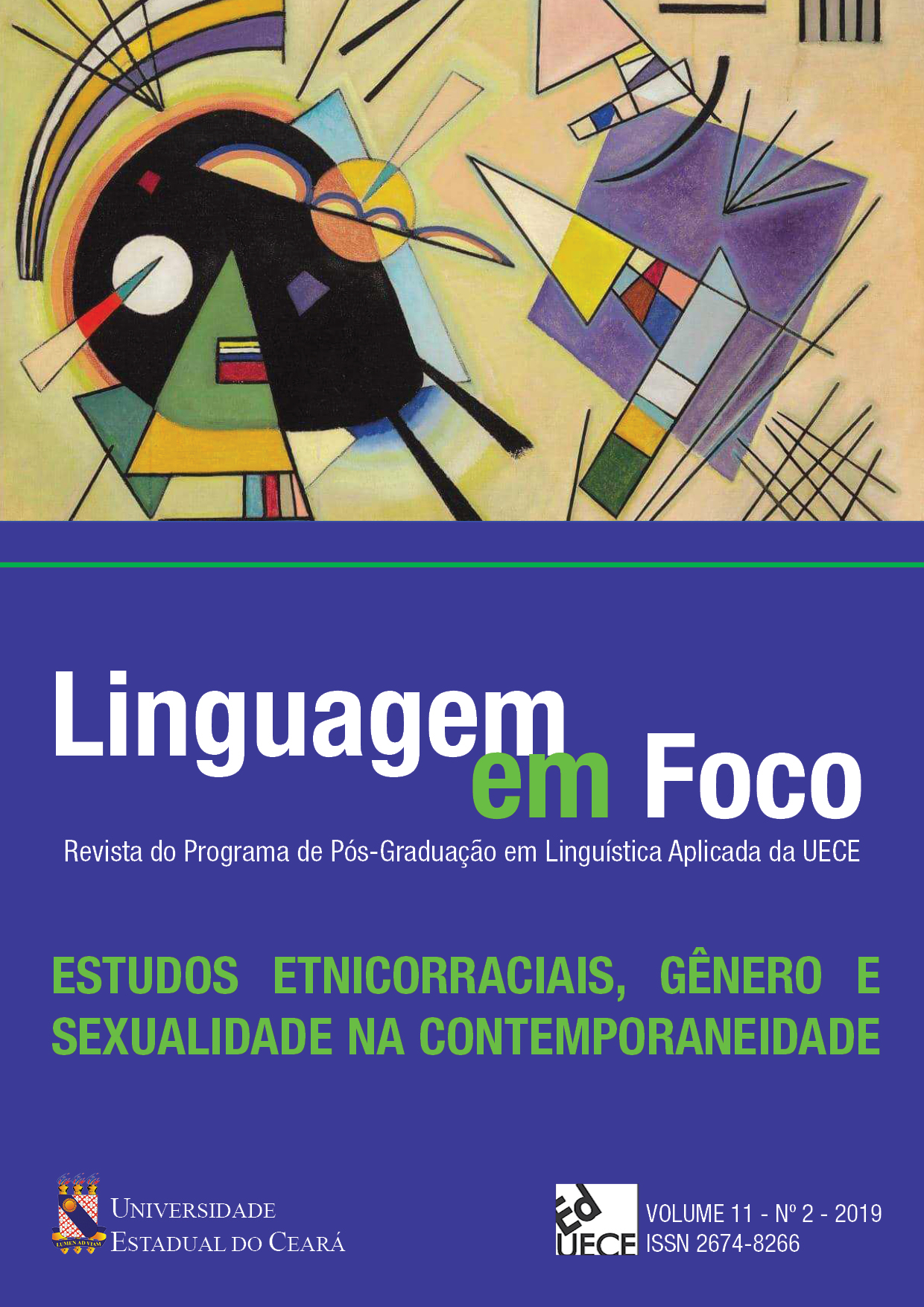Meanings Around the Transsexual Body
The Medico-Scientific Discourse in David Ebershoff’s The Danish Girl
DOI:
https://doi.org/10.46230/2674-8266-11-2919Keywords:
The Danish girl, body, discourse, medico-scientific, transsexualityAbstract
This article aims to discuss meanings related to the transsexual body through the medico-scientific discourse used to construct the character of Lili Elbe, a transsexual woman, in David Ebershoff's The Danish Girl. The theoretical framework includes studies on an interdisciplinary queer approach in applied linguistics (MOITA LOPES, 2006; FABRICIO, 2017; BUTLER, 1990; SALIH, 2017; MISKOLCI, 2017), as well as on transsexual corporeality in medico-scientific discourse (BENTO, 2008, 2014; CASSANA, 2018; DENARDIN, 2019). The methodological framework is that of analytical and interpretative research. For data generation, selected extracts from Ebershoff’s novel were analyzed to verify how the medico-scientific discourse is constructed throughout the narrative. In the story, the main character Lili or Einar Wegener is described as someone who lives within a dual process that sways between two different personas, one male (Einar) and one female (Lili, who emerges over the course of the plot). Even though this character uses medico-scientific discourse(s) as a means of self-justification, it comes forth as collaboration with the pathologizing process associated with transsexual women, still largely viewed as carriers of personality disorders related to sexuality. Results indicate the establishment of an essentiality between gender identity and sexuality, based on the interrelatedness of medico-scientific discourses and the binary gender essentialism found in society (man/woman, male/female). This phenomenon fails to legitimize the social standing of trans people, who have always been a part of society.
Downloads
References
BENTO, B. O que é transexualidade? São Paulo: Editora Brasiliense, 2008.
_____. A reinvenção do corpo: sexualidade e gênero na experiência transexual. 2. ed. Natal: EDUFRN, 2014.
BISIAK, J. dos S. O gênero sexual como cárcere e como liberdade: A garota dinamarquesa, de David Ebershoff, na perspectiva do performativo e da alternância de sujeitos. Revista Periodicus, Salvador, v. 1, n. 7, 2017.
BRITO, E. R. de. Relações imagéticas entre artes plásticas e cinema: universos paralelos? Problematizando a elaboração de “A garota dinamarquesa”. 2018. 306f. Tese (Doutorado em Educação, Arte e História da Cultura) – Programa Multidisciplinar em Educação, Arte e História da Cultura, Universidade Presbiteriana Mackenzie, São Paulo, 2018.
BUTLER, J. Problemas de gênero: feminismo e subversão da identidade. Rio de Janeiro: Civilização Brasileira, 1990.
CASSANA, M. F. Corpo e(m) discurso: ressignificando a transexualidade. Curitiba: Editora Appris, 2018.
DENARDIN, J. Â. dos S. O discurso televisivo e o sujeito transexual: sentidos e silenciamentos na mídia. 2019. 135f. Dissertação (Mestrado em Letras) – Universidade Estadual do Oeste do Paraná, Cascavel, 2019.
EBERSHOFF, D. A garota dinamarquesa. Rio de Janeiro: Fábrica231, 2016.
FARIA, I. M. D.; RIBEIRO, K. C. R. A garota dinamarquesa: uma abreviada apreensão psicanalítica. Revista PsicoFAE, Pluralidades em Saúde Mental, v. 4, n. 1, 2015.
FABRÍCIO, B. F. Linguística aplicada e visão de linguagem: por uma (in)disciplinaridade radical. Revista Brasileira de Linguística Aplicada, v. 1, p. 1-19, 2017.
FOUCAULT, M. História da sexualidade I: A vontade de saber. São Paulo: Graal, 2009.
MISKOLCI, R. Teoria queer: um aprendizado pelas diferenças. 3. ed. Belo Horizonte: Autêntica, 2017.
MOITA LOPES, L. P. da. Da aplicação de Linguística à Linguística Aplicada Indisciplinar. In: ______ (Org.). Por uma Linguística Aplicada Indisciplinar. São Paulo: Parábola, 2006.
MOURA, et al. Transexualidades: Considerações psicanalíticas a partir do filme "A garota dinamarquesa". Revista Interfaces Científicas, v. 7, n. 1, 2018.
OCARIZ, M. C. O sintoma e a clínica psicanalítica: O curável e o que não tem cura. São Paulo: Via Lettera, 2003.
SALIH, S. Judith Butler e a Teoria Queer. 4. ed. Belo Horizonte: Autêntica, 2017.
SOUZA, D. dos S.; ZOLIN-VESZ, F. Da hospitalidade à intolerância ao migrante árabe: construções discursivas sobre um mesmo Brasil. Trabalhos em Linguística Aplicada, v. 57, p. 877-893, 2018.
TOPCZEWSKI, C. S. A garota dinamarquesa. Revista Nova Perspectiva Sistêmica, São Paulo, v. 25, n. 55, 2016.
Downloads
Published
How to Cite
Issue
Section
License
Copyright (c) 2020 Dánie Marcelo de Jesus, Gabriel Marchetto, Jaqueline Ângelo dos Santos Denardin

This work is licensed under a Creative Commons Attribution 4.0 International License.
Authors who publish in Linguagem em Foco Scientific Journal agree to the following terms:
- Authors retain the copyright and grant the journal the right of first publication. The articles are simultaneously licensed under the Creative Commons Attribution License which allows sharing the work with an acknowledgement of its authorship and initial publication in this journal.
- The concepts issued in signed articles are the absolute and exclusive responsibility of their authors. Therefore, we request a Statement of Copyright, which must be submitted with the manuscript as a Supplementary Document.
- Authors are authorized to make the version of the text published in Linguagem em Foco Scientific Journal available in institutional repositories or other academic work distribution platforms (ex. ResearchGate, Academia.edu).





























